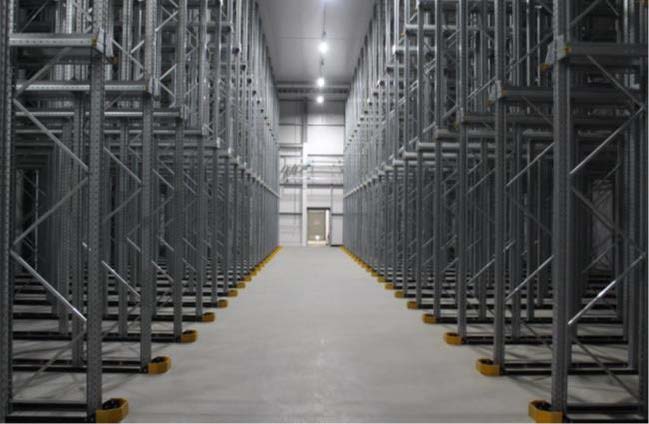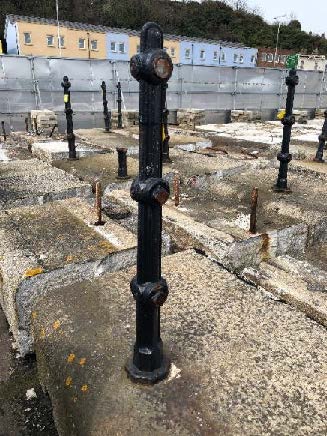Dover’s Western Docks Revival project gets CEEQUAL rating of Excellent
Overview

The Dover Western Docks Revival (DWDR) project had a huge impact on the busy port. Designed and built to high sustainability standards and improving the local area, it earned a CEEQUAL (now known as BREEAM Infrastructure) rating of 89.2%.
About
Established in 1606, the Dover Harbour Board (DHB) are to administers and maintains the Port of Dover and its facilities. The body is also responsible for developing resources to meet future demands.
Background
Dover Western Docks Revival (DWDR) was a one-off opportunity for the regeneration of Dover, bringing new investment into the area. With UK government planning approval and supported by a mix of private finance and European Union grant funding, the project goal was to benefit the local economy and community.

Challenges
The goals of this project was high and all-encompassing, they included:
Relocation and further development of the cargo business with a new cargo terminal and distribution centre;
Creation of greater space within the Eastern Docks for ferry traffic;
A transformed waterfront to ultimately attract a host of shops, bars, cafes and restaurants with Dover’s unique backdrop of the harbour, cliffs and castle; and
Much needed quality employment opportunities for local people.
In order to meet and surpass these challenges, preparation for this project was crucial. VFL was appointed as the principal contractor to deliver the Paving, Utilities and Infrastructure (PUI) project which includes the installation of works within the cargo terminal and joining the existing road networks to the new cargo entrance.
The works comprises of all heavy duty and highways paving and footpaths, structures and small buildings, fencing and vehicle barriers. This scope of services also includes lighting, CCTV, all foul and surface water drainage, electrical and data distributions, access control systems, water and fire mains.
Refrigerated Cargo Building
BGL was appointed as the principal contractor to deliver the construction of the 9640sqm Refrigerated Cargo Building located on the existing Hoverport within the Western Dock. Situated in an exposed maritime environment and operating 24 hours a day, handling 600,000 tonnes of cargo per annum, the building is of a robust design and construction with a 25-year design life.
This building is an externally clad steel frame with 9 sections, 2 refrigerated discharge chambers, 6 refrigerated storage chambers and an out load area with 20 dock levellers. The chambers are mechanically ventilated to provide 2 air changes per hour, and can be temperature controlled within +1 and +14° C.
On the roof, photovoltaic panels installed by Evo Energy can generate 1000kW through solar power, and this forms a key part of the building’s sustainability.
Marina Office
WWM was appointed as the principal contractor to deliver the construction of the Marina Office located between the existing Wellington Dock and the new marina adjacent to the new navigational channel, bascule bridge and lock gates. The new facilities replace the existing control building and will be operational 24 hours a day 7 days a week. Its purpose is to monitor vessel movement & activity within the new marina and the existing Wellington Dock.
This building was constructed to a high quality to ensure the specific operational, environmental and user requirements was achieved, at the same time ensuring performance in use with robust construction detailing and low maintenance over the lifetime of the building. Designed as a modern brick and glass building.
The Clock Tower Square
The next stage of the works focused on the creation of the public area, Clock Tower Square, landscaping and Marina Curve, and new marina facilities. The Clock Tower Square which houses the former Grade 2 Life Boat Station will become the historic ‘legacy’ of the development, and focal point of the public realm feeding into the Stage 3 phase of the works. This will be a design incorporating historic granite and coping stones alongside restored heritage furniture whilst overlooking the new marina.


Solutions
People and communities (score: 86%)
The Port of Dover – promoter of the DWDR project – has prioritised consultation with stakeholders and the community from the earliest development stages, aware that the proposed changes need to be acceptable to and welcomed by the established Dover community and visitors, and with the Port’s dedicated customer base across all its business streams.
This has been undertaken through a variety of means including an inaugural two-week promotion of DWDR at the project’s dedicated Marketing Suite, the regular quarterly Port and Community Forum (PCF) and Port User Group (PUG), the Marina Users Engagement Group, the monthly Harbour and Leisure Group and numerous one-to-one meetings and external presentations involving around 200 different stakeholder groupings. The project’s Marketing Suite is also open to the public every Wednesday to act as a drop-in centre and educational platform for all stakeholder groups.
The considerable input and feedback received has been invaluable and the Port worked hard to address all of the concerns and issues raised. This included a number of significant adjustments to aspects of the design. Examples include the decision to feature the Clock Tower building as a centrepiece and retain the Prince of Wales Pier lighthouse in order to preserve these aspects of the Port’s heritage.
The ongoing Marina Users Engagement Group meetings are designed to give the marina community an insight into the design development principles and keep them engaged throughout the construction stages of the DWDR project.
Historic environment (score: 93%)
The concept of the project was developed in 2008 and desktop studies were conducted by Canterbury Archaeological Trust to identify, in advance, the potential heritage management requirements and what may be hidden in areas requiring deeper excavations. Buildings and assets of historic significance were identified in the baseline studies and contingencies made for those affected or in close proximity to the project.
Full heritage recording took place before construction work started which allowed for reviews to be undertaken before any work affecting the historic environment was underway and time could be taken to discuss all possible options.
Areas being developed that contain historic buildings have been designed in such a way as to be sympathetic to the character of the area, whilst planning for sustainability of the area in the future. This includes design, materials used and layouts implemented. All historical research undertaken for the project and any archaeological reports will be made publicly available following project completion.
As the impacts on the historic environment are hugely important, the DWDR scheme was designed to minimise the loss of historic character, which includes the retention of the Wellington Dock with a new navigable channel to/from the new marina.
A Heritage Steering Group (HSG) was formed in the early stages, in order to meet the design delivery of the project’s heritage requirements. This group comprises participants from the project team and external heritage organisations and statutory bodies, and was supported by a full-time dedicated conservation officer. The HSG advised that archaeologists would be present on site for any excavation works completed in the historical past of the Western Docks, Dover.
Specialist heritage experts, Archaeology South-East (ASE), were contracted to oversee the excavation to ensure the requisite investigations were conducted in a controlled and timely environment.
Decisions made within the HSG were then filtered through to the project managers on the project and all site operatives were briefed accordingly. Protocols were established to mobilise archaeologists in the event that when anything resembling a find was unearthed to ensure appropriate precautions could be put in place. Archaeologists controlled excavation of sensitive areas, particularly the Wellington Dock navigation channel and all discoveries were examined, documented and stored.
Before any historic assets were removed from their original location, a plan was made for their restoration and relocation into a new heritage development area. This ensured their protection for future generations.
Alongside the asset protection, precautions were also developed for the listed buildings on site. A survey was undertaken to identify all heritage assets before any works were undertaken in order to evaluate which assets would require protection; those within close proximity to the site and construction works required extra monitoring. Vibration monitors, movement monitoring gauges and protection zones were installed where appropriate, with all assets to be monitored for the duration of the project.
There are areas where the design and build has or will reuse or enhance heritage features, the listed building material and furniture includes light columns, bollards, railings, granite copings and setts.
Ecology and biodiversity (score: 94%)
The Port was required to have a Client Construction Environmental Management Plan (CCEMP) which prescribed the requirements of the agreements reached with conservation bodies to be managed by the designers and contractors during the design and construction phases. The CCEMP communicated the ecological specifications of the project and details the ecological management requirements.
The Port of Dover continues to run an environmental monitoring programme throughout the course of the DWDR Project, including surveys of birds, marine life and terrestrial ecology. Once the construction is complete new habitats will be added and monitored across the DWDR area. The results of this ongoing environmental monitoring are to be communicated to the public and other interested parties through an annual monitoring report e.g. every summer, butterfly conservation is undertaking a Fiery Clearwing moth survey, on the Shakespeare beach.
Water environment (score: 100%)
To comply with the relevant legislation, DWDR was approved with a Harbour Revision Order (HRO) granted by the Department of Transport in 2012. The HRO sets a period of 10 years for the work to start. Additionally, Marine Licences have been obtained from the Marine Management Organisation (MMO), allowing the Port of Dover to carry out the construction activities under Part 4 of the Marine and Coastal Access Act 2009.
To minimise the input of contaminants from the Port’s use of the roads, infrastructure and other hard standing areas, six full retention interceptors have been installed for the surface water drainage to minimise any risk of spills and releases reaching the marine environment from the completed port.
For the new marina boatyard a separate drainage system has been designed to manage the pollution from use of detergents at the boat wash down and maintenance area. On the Marina Curve a separate drainage system has been provided for the fuel farm. This has a full retention interceptor in case of fuel spills.
To reduce the impact from passing commercial and recreational vessels in the harbour, Vessel Traffic Services implemented speed restrictions as a way of minimising sediment re-suspension. A new Marine Pollution Response Plan (MPRP) has been implemented which describes in detail, contingency plans for operational marine pollution.
The Port continues to undertake water quality surveys across the port every six months to monitor port operations and the project’s impacts on the freshwater and marine environment.
Transport (score: 97%)
To minimise disruption to the local highways caused by construction traffic, significant quantities of construction materials for the project were delivered by sea. A concrete batching plant was established on site to produce the paving and all the aggregate for the batching plant were delivered by sea. In total 139,302 tonnes were brought to site by VFL in marine deliveries eliminating the need for approximately 7000 lorry movements.


Benefits
Reflecting on the success of the project overall, a spokesperson commented, “The CEEQUAL assessment provided a management tool for the project team to conduct an overall review on the sustainability of the project. Throughout the process, the project team identified areas of improvement for incorporation into future project elements to enhance sustainability performance.”
They continued, “CEEQUAL is most beneficial when implemented from conception to completion and all project team members are fully engaged in the process. The benefits include enhanced record keeping and ensuring environmental issues remain a key element of the delivery. The Port employs a full-time environmental advisor to drive the CEEQUAL assessment initiative, recognising that time and dedication are necessary for the project to be a success.”

Summary
Dover Developments Ltd, Buckingham Group Contracting Ltd, Volker Fitzpatrick Ltd, W.W. Martin Ltd.
